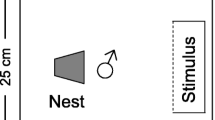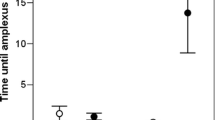Summary
This paper extends previously published observations of the sexual behavior of the redspotted newt. In encounters between single males and females, the male either performs a brief lateral, or ‘hula’, display or clasps the female and holds her in amplexus for as long as 3 h.
Experimental manipulation of the ambient sex ratio in an observation aquarium showed that the number of females available to a male did not influence his ‘decision’ whether to perform hula display or-attempt amplexus. In the presence of other males, a courting male showed a greater tendency to adopt the amplexus mode of courtship.
Males interfered with one another's attempts to court and inseminate females. Unpaired males tried to displace those engaged in amplexus, but were seldom successful. During the spermatophore deposition and transfer stage of both courtship modes, unpaired males mimicked female behavior, apparently in order to obtain inseminations. Hula courtships were the most vulnerable to this type of competition; multiple insemination of the female was occasionally observed.
The various costs and benefits associated with the various sexual strategies of male newts are discussed, together with some relevant ecological data. Similarly complex behavior in some other animals is also considered.
Similar content being viewed by others
References
Arnold SJ (1972) The evolution of courtship behaviour in salamarders. PhD, Univ of Michagan
Arnold SJ (1976) Sexual behavior, sexual interference and sexual defense in the salamanders Ambystoma maculatum, Ambystoma tigrinum and Plethodon jordani. Z Tierpsychol 42:247–300
Arnold SJ (1977) The evolution of courtship behaviour in New World salamanders with some comments on Old World salamanders. In: Taylor DH, Guttman SI (eds) The reproductive biology of amphibians. Plenum Press, New York, pp 141–183
Anold SJ, Houck LD (1982) Courtship pheromones: evolution by natural and sexual selection. In: Nitecki MH (ed) Biochemical aspects of evolutionary biology. Univ Chicago Press, Chicago pp 173–211
Conant R (1975) A field guide to reptiles and amphibians of eastern and central North America. Houghton Mifflin, Boston
Davies NB (1982) Behaviour and competition for scarce resources. In: King's College Sociobiology Group (eds) Current problems in sociobiology. Cambridge Univ Press, Cambridge, pp 363–380
Dawkins R (1980) Good strategy or evolutionarily stable strategy? In: Barlow GW, Silverberg J (eds) Sociobiology: beyond nature/nurture? Westview Press, Colorado, pp 331–367
Dent JN (1970) The ultrastructure of the spermatheca in the red-spotted new. J Morphol 132:397–424
Dunbar RIM (1982) Intraspecific variations in mating strategy. In: Bateson PPG, Klopfer PH (eds) Perspectives in ethology, vol 5. Plenum Press, New York, pp 385–431
Emlen ST, Oring LW (1977) Ecology, sexual selection and the evolution of mating systems. Science 197:215–223
Gill DE (1978) The metapopulation ecology of the red-spotted newt, Notophthalmus viridescens (Rafinesque). Ecol Monogr 48:145–166
Halliday TR, Verrell PA (1983) Sperm competition in amphibians. In Smith RL (ed) Sperm competition and the evolution of animal mating systems. Academic Press, London
Healy WR (1974) Population consequences of alternative life histories in Notophthalmus viridescens. Copeia 1974:221–229
Humphries AA (1955) Observations on the mating behaviour of normal and pituitary-implanted Triturus viridescens. Physiol Zool 28:73–79
Hurlbert SH (1969) The breeding migrations and inter-habitat wandering of the vermilion-spotted newt, Notophthalmus viridescens (Rafinesque). Ecol Monogr 39:465–488
Parker GA (1970) Sperm competition and its evolutionary consequences in the insects. Biol Rev 45:525–568
Parker GA (1974) Courtship persistence and female guarding as male time investment strategies. Behaviour 48:157–184
Pope PH (1924) The life-history of the common newt (Notophthalmus viridescens), together with observations on the sense of smell. Ann Carnegie Mus 15:305–368
Ritter WE (1897) Diemyctylus torosus Esch. The life history and habits of the Pacific Coast newt. Proc Calif Acad Sci III Zool 1:73–114
Smith RE (1941) Mating behaviour in Triturus torosus and related newts. Copeia 1941:255–262
Thornhill R (1981) Pamorpa (Mecoptera: Panorpidae) scorpion-flies: systems for understanding resource-defense polygyny and alternative male reproductive efforts. Annu Rev Ecol Syst 12:355–386
Verrell PA (1982a) The sexual behaviour of the red-spotted newt, Notophthalmus viridescens (Amphibia: Urodela: Salamandridae). Anim Behav 30:1224–1236
Verrell PA (1982b) A note on the maintenance of the redspotted newt in captivity. Br Herpetol Soc Bull 5:24
Verrell PA (1982c) Male newts prefer large females as mates. Anim Behav 30:1254–1255
Verrell PA (in press) Sexual interference and sexual defense in the smooth newt, Triturus vulgaris (Amphibia: Urodela: Salamandridae). Z Tierpsychol
Author information
Authors and Affiliations
Rights and permissions
About this article
Cite this article
Verrell, P.A. The influence of the ambient sex ratio and intermale competition on the sexual behavior of the red-spotted newt, Notophthalmus viridescens (Amphibia: Urodela: Salamandridae). Behav Ecol Sociobiol 13, 307–313 (1983). https://doi.org/10.1007/BF00299678
Received:
Accepted:
Issue Date:
DOI: https://doi.org/10.1007/BF00299678




